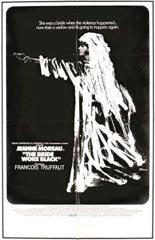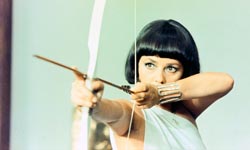
 Thirty-five years before Uma Thurman’s Kill Bill bride murdered her way through a five-person list to avenge the assassination of her would-be hubby, Jeanne Moreau did the same in The Bride Wore Black. The film was director François Truffaut’s homage to the suspense thrillers of Alfred Hitchcock, whom the French New Wave pioneer interviewed in the now-essential cinema-study text Hitchcock/Truffaut, published one year before.
Thirty-five years before Uma Thurman’s Kill Bill bride murdered her way through a five-person list to avenge the assassination of her would-be hubby, Jeanne Moreau did the same in The Bride Wore Black. The film was director François Truffaut’s homage to the suspense thrillers of Alfred Hitchcock, whom the French New Wave pioneer interviewed in the now-essential cinema-study text Hitchcock/Truffaut, published one year before.
For this stylish tribute, Truffaut brought frequent Hitch composer Bernard Herrmann (Psycho) along for the tour and tapped a crime novel by Cornell Woolrich, who wrote the short story on which Hitch’s Rear Window was based.
While the details surrounding the shooting are held from viewers too long that confusion initially reigns, brand-new wife Julie Kohler (Moreau, La Femme Nikita) watches in horror as the love of her life is shot dead on the church steps, presumably seconds after the ceremony bound them ’til death do they part.
One thwarted suicide attempt later, the grieving, perpetually frowning Julie decides to move on with life, as in getting even with the quintet of card-playing bachelors responsible for her spouse’s untimely demise. As she does so, each through a wildly different method — pushing, poisoning, whatev — she crosses off the poor bastard’s name in her little black book. (An avenger’s trade secret? Accurate, real-time record-keeping.)
Even masters of cinema have their missteps, and that’s how Bride may strike viewers who look at it strictly as an exercise in the Hitchcock vein. Without Herrmann’s score in place, the movie doesn’t feel the slightest Hitchcockian; heck, Moreau isn’t even blonde! To be fair, approach Truffaut as Truffaut. The French approach genre markedly different than the English, and Bride is his take on the thriller as Fahrenheit 451 was his take on sci-fi: an ambitious, if not entirely successful marriage of art and commerce. With an unexpected sequence of animation, the film is always interesting to look at, even when the story points lag. Don’t pay too much attention beyond what resides at the surface, because Truffaut didn’t; in fact, he left open a huge plot hole — upon which the entire work hinges. —Rod Lott

